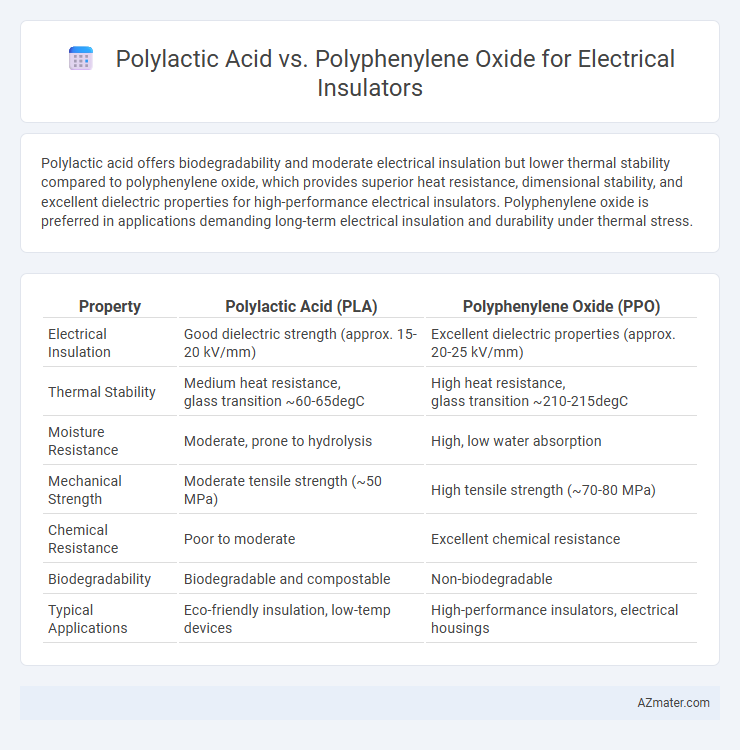Polylactic acid offers biodegradability and moderate electrical insulation but lower thermal stability compared to polyphenylene oxide, which provides superior heat resistance, dimensional stability, and excellent dielectric properties for high-performance electrical insulators. Polyphenylene oxide is preferred in applications demanding long-term electrical insulation and durability under thermal stress.
Table of Comparison
| Property | Polylactic Acid (PLA) | Polyphenylene Oxide (PPO) |
|---|---|---|
| Electrical Insulation | Good dielectric strength (approx. 15-20 kV/mm) | Excellent dielectric properties (approx. 20-25 kV/mm) |
| Thermal Stability | Medium heat resistance, glass transition ~60-65degC |
High heat resistance, glass transition ~210-215degC |
| Moisture Resistance | Moderate, prone to hydrolysis | High, low water absorption |
| Mechanical Strength | Moderate tensile strength (~50 MPa) | High tensile strength (~70-80 MPa) |
| Chemical Resistance | Poor to moderate | Excellent chemical resistance |
| Biodegradability | Biodegradable and compostable | Non-biodegradable |
| Typical Applications | Eco-friendly insulation, low-temp devices | High-performance insulators, electrical housings |
Introduction to Electrical Insulators
Electrical insulators are materials that inhibit the flow of electric current, ensuring safety and performance in electrical systems. Polylactic acid (PLA) offers biodegradability and mechanical strength but has limited thermal stability compared to Polyphenylene oxide (PPO), which provides superior heat resistance and electrical insulation properties. PPO's enhanced dielectric constant and thermal endurance make it a preferred choice for high-performance electrical insulators in demanding applications.
Overview of Polylactic Acid (PLA)
Polylactic acid (PLA) is a biodegradable thermoplastic derived from renewable resources such as corn starch and sugarcane, making it an eco-friendly alternative for electrical insulation applications. PLA exhibits good dielectric properties, including high volume resistivity and dielectric strength, which make it suitable for low-voltage electrical insulators. Its mechanical strength and thermal stability are moderate compared to Polyphenylene oxide (PPO), but PLA's biodegradability and cost-effectiveness offer distinct advantages in sustainable electrical component manufacturing.
Overview of Polyphenylene Oxide (PPO)
Polyphenylene oxide (PPO) is a high-performance thermoplastic known for its excellent electrical insulating properties, thermal stability, and dimensional stability, making it ideal for electrical insulator applications. PPO offers superior dielectric strength and low moisture absorption compared to polylactic acid (PLA), which enhances reliability in demanding electrical environments. Its inherent flame resistance and chemical resistance further contribute to PPO's suitability in advanced electrical systems requiring durable and stable insulating materials.
Dielectric Properties Comparison
Polylactic acid (PLA) exhibits a dielectric constant typically around 3.0 to 3.5 and low dielectric loss, making it suitable for biodegradable electrical insulators with moderate performance. Polyphenylene oxide (PPO) offers superior dielectric properties, including a higher dielectric strength often exceeding 20 kV/mm and a stable dielectric constant near 2.7, resulting in enhanced electrical insulation reliability. PPO's thermal stability and moisture resistance further improve its dielectric behavior compared to the more hydrophilic and thermally sensitive PLA, positioning PPO as the preferred material for high-performance electrical insulators.
Thermal Stability and Performance
Polylactic acid (PLA) offers biodegradability but exhibits limited thermal stability with a glass transition temperature around 60degC, making it less suitable for high-temperature electrical insulator applications. Polyphenylene oxide (PPO) demonstrates superior thermal stability with a continuous use temperature exceeding 150degC, providing excellent dimensional stability and electrical insulation performance under elevated thermal conditions. PPO's higher thermal endurance and mechanical strength make it the preferred material for demanding electrical insulator components.
Mechanical Strength and Durability
Polylactic acid (PLA) offers moderate mechanical strength and biodegradability but generally lacks the long-term durability required for demanding electrical insulator applications. Polyphenylene oxide (PPO) exhibits superior mechanical strength with high impact resistance and excellent thermal stability, making it more suitable for harsh electrical environments. PPO's enhanced dimensional stability and resistance to electrical degradation outperform PLA, ensuring prolonged service life in insulation roles.
Environmental Impact and Sustainability
Polylactic acid (PLA) offers biodegradable properties and is derived from renewable resources like corn starch, reducing reliance on fossil fuels and decreasing greenhouse gas emissions during production. Polyphenylene oxide (PPO), while providing excellent electrical insulation and thermal stability, is petroleum-based and less environmentally friendly due to its non-biodegradability and higher carbon footprint. PLA supports sustainable circular economy goals through compostability, whereas PPO's durability poses challenges for waste management and recycling in electrical insulation applications.
Cost Efficiency and Availability
Polylactic acid (PLA) offers cost efficiency due to its biodegradability and lower raw material expenses, making it an economical choice for electrical insulation in low to medium voltage applications. Polyphenylene oxide (PPO) provides superior thermal stability and electrical insulation properties but comes at a higher price point, limiting its cost-effectiveness for large-scale or budget-sensitive projects. Availability of PLA is generally higher worldwide due to its bio-based production from renewable resources, whereas PPO is synthesized through more complex chemical processes, affecting its global accessibility and supply consistency.
Typical Applications in Electrical Insulation
Polylactic acid (PLA) is commonly used in electrical insulation for biodegradable and environmentally friendly applications such as insulating films, coatings, and housings in consumer electronics. Polyphenylene oxide (PPO) offers superior thermal stability and dielectric properties, making it ideal for high-performance electrical insulators in automotive connectors, circuit breakers, and appliance components. PLA suits low-temperature, short-term insulation needs, while PPO excels in demanding environments requiring long-term durability and resistance to heat and electrical stress.
Conclusion: Choosing the Right Material
Polylactic acid (PLA) offers biodegradability and ease of processing, making it suitable for eco-friendly electrical insulators with moderate thermal and electrical performance. Polyphenylene oxide (PPO) provides superior thermal stability, excellent dimensional stability, and high dielectric strength, ideal for demanding electrical insulation applications. Selecting the right material depends on balancing environmental impact, thermal requirements, and electrical performance criteria specific to the application.

Infographic: Polylactic acid vs Polyphenylene oxide for Electrical Insulator
 azmater.com
azmater.com